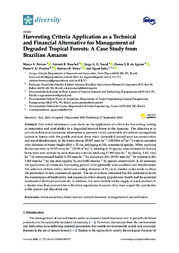Harvesting criteria application as a technical and financial alternative for management of degraded tropical forests: a case study from Brazilian Amazon.
Harvesting criteria application as a technical and financial alternative for management of degraded tropical forests: a case study from Brazilian Amazon.
Autoria: SIVIERO, M. A.; RUSCHEL, A. R.; YARED, J. A. G.; AGUIAR, O. J. R. de; PEREIRA, P. C. G.; VIEIRA, S. B.; SALES, A.
Resumo: This article addresses a case study on the application of criteria for harvesting, aiming at restoration and profitability in a degraded tropical forest in the Amazon. The objective is to provide technical and economic information to promote a truly sustainable silvicultural management system in forests with this profile and turn them into a desirable financial asset for conservation and social development. In the forest census, 85.907 trees ha−1 (100.8566 m3 ha−1) were inventoried with diameter at breast height (dbh) ≥ 25 cm, belonging to 106 commercial species. When applying the harvest criteria, 19.923 trees ha−1 (29.99 m3 ha−1), referring to 53 species, were destined for harvest. Some trees were selected by more than one criterion, totalizing 17.985 trees ha−1 by density, 1.831 trees ha−1 by compromised health, 0.212 trees ha−1 by maximum dbh, 18.933 trees ha−1 by minimum dbh, 1.385 trees ha−1 by tree stem (quality 3), and 0.080 trees ha−1 by species conservation. In all scenarios, the application of criteria for harvesting proved to be profitable with excellent cost?benefit ratios. The selection of trees with a minimum cutting diameter of 25 cm in shorter cycles tends to allow the promotion of new commercial species. The set of actions presented has the potential to favor the maintenance of biodiversity and expansion of low-density populations, health and the potential increment of the forest productivity. In addition, it is more feasible for the supply of forest products in a shorter time than provided for in Brazilian regulations; however, they must respect the specificities of the species and also of the site
Ano de publicação: 2020
Tipo de publicação: Artigo de periódico
Unidade: Embrapa Amazônia Oriental
Palavras-chave: Colheita, Diâmetro, Economia Florestal, Floresta Nativa, Manejo
Observações
1 - Por padrão são exibidas publicações dos últimos 20 anos. Para encontrar publicações mais antigas, configure o filtro ano de publicação, colocando o ano a partir do qual você deseja encontrar publicações. O filtro está na coluna da esquerda na busca acima.
2 - Para ler algumas publicações da Embrapa (apenas as que estão em formato ePub), é necessário ter, no celular ou computador, um desses softwares gratuitos. Sistemas Android: Google Play Livros; IOS: iBooks; Windows e Linux: software Calibre.
Acesse outras publicações
Acesse a Base de Dados da Pesquisa Agropecuária (BDPA) para consultar o acervo completo das bibliotecas da Embrapa.

